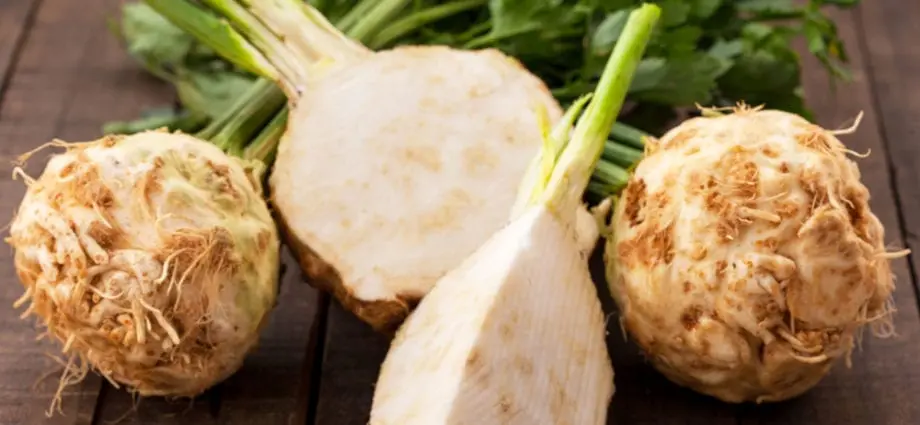Nutritional value and chemical composition.
The table shows the content of nutrients (calories, proteins, fats, carbohydrates, vitamins and minerals) per 100 grams edible part.
| Nutrient | Quantity | Norm** | % of the norm in 100 g | % of the norm in 100 kcal | 100% normal |
| Calorie value | 42 kCal | 1684 kCal | 2.5% | 6% | 4010 g |
| Proteins | 1.5 g | 76 g | 2% | 4.8% | 5067 g |
| Fats | 0.3 g | 56 g | 0.5% | 1.2% | 18667 g |
| Carbohydrates | 7.4 g | 219 g | 3.4% | 8.1% | 2959 g |
| Alimentary fiber | 1.8 g | 20 g | 9% | 21.4% | 1111 g |
| Water | 88 g | 2273 g | 3.9% | 9.3% | 2583 g |
| Ash | 1 g | ~ | |||
| Vitamins | |||||
| Lutein + Zeaxanthin | 1 μg | ~ | |||
| Vitamin B1, thiamine | 0.05 mg | 1.5 mg | 3.3% | 7.9% | 3000 g |
| Vitamin B2, riboflavin | 0.06 mg | 1.8 mg | 3.3% | 7.9% | 3000 g |
| Vitamin B4, choline | 9 mg | 500 mg | 1.8% | 4.3% | 5556 g |
| Vitamin B5, pantothenic | 0.352 mg | 5 mg | 7% | 16.7% | 1420 g |
| Vitamin B6, pyridoxine | 0.165 mg | 2 mg | 8.3% | 19.8% | 1212 g |
| Vitamin B9, folate | 8 μg | 400 μg | 2% | 4.8% | 5000 g |
| Vitamin C, ascorbic | 8 mg | 90 mg | 8.9% | 21.2% | 1125 g |
| Vitamin E, alpha tocopherol, TE | 0.36 mg | 15 mg | 2.4% | 5.7% | 4167 g |
| Vitamin K, phylloquinone | 41 μg | 120 μg | 34.2% | 81.4% | 293 g |
| Vitamin PP, NE | 0.7 mg | 20 mg | 3.5% | 8.3% | 2857 g |
| Macronutrients | |||||
| Potassium, K | 300 mg | 2500 mg | 12% | 28.6% | 833 g |
| Calcium, Ca | 43 mg | 1000 mg | 4.3% | 10.2% | 2326 g |
| Magnesium, Mg | 20 mg | 400 mg | 5% | 11.9% | 2000 g |
| Sodium, Na | 100 mg | 1300 mg | 7.7% | 18.3% | 1300 g |
| Sulfur, S | 15 mg | 1000 mg | 1.5% | 3.6% | 6667 g |
| Phosphorus, P | 115 mg | 800 mg | 14.4% | 34.3% | 696 g |
| Trace Elements | |||||
| Iron, Fe | 0.7 mg | 18 mg | 3.9% | 9.3% | 2571 g |
| Manganese, Mn | 0.158 mg | 2 mg | 7.9% | 18.8% | 1266 g |
| Copper, Cu | 70 μg | 1000 μg | 7% | 16.7% | 1429 g |
| Selenium, Se | 0.7 μg | 55 μg | 1.3% | 3.1% | 7857 g |
| Zinc, Zn | 0.33 mg | 12 mg | 2.8% | 6.7% | 3636 g |
| Digestible carbohydrates | |||||
| Mono- and disaccharides (sugars) | 1.6 g | max 100 г | |||
| Saturated fatty acids | |||||
| Saturated fatty acids | 0.079 g | max 18.7 г | |||
| 14: 0 Myristic | 0.002 g | ~ | |||
| 16: 0 Palmitic | 0.069 g | ~ | |||
| 18: 0 Stearin | 0.006 g | ~ | |||
| Monounsaturated fatty acids | 0.058 g | min 16.8 г | 0.3% | 0.7% | |
| 16: 1 Palmitoleic | 0.002 g | ~ | |||
| 18: 1 Olein (omega-9) | 0.056 g | ~ | |||
| Polyunsaturated fatty acids | 0.148 g | from 11.2 to 20.6 | 1.3% | 3.1% | |
| 18: 2 Linoleic | 0.148 g | ~ | |||
| Omega-6 fatty acids | 0.148 g | from 4.7 to 16.8 | 3.1% | 7.4% |
The energy value is 42 kcal.
- cup = 156 g (65.5 kCal)
Celery, root rich in vitamins and minerals such as: vitamin K – 34,2%, potassium – 12%, phosphorus – 14,4%
- Vitamin K regulates blood clotting. Lack of vitamin K leads to an increase in blood clotting time, a lowered content of prothrombin in the blood.
- potassium is the main intracellular ion that takes part in the regulation of water, acid and electrolyte balance, participates in the processes of nerve impulses, pressure regulation.
- Phosphorus takes part in many physiological processes, including energy metabolism, regulates acid-base balance, is a part of phospholipids, nucleotides and nucleic acids, is necessary for the mineralization of bones and teeth. Deficiency leads to anorexia, anemia, rickets.
Tags: calorie content 42 kcal, chemical composition, nutritional value, vitamins, minerals, how Celery is useful, root, calories, nutrients, useful properties of Celery, root










